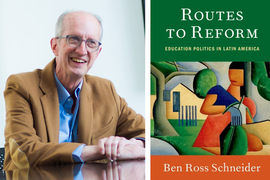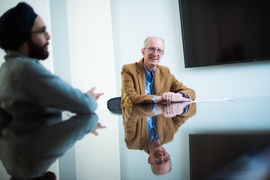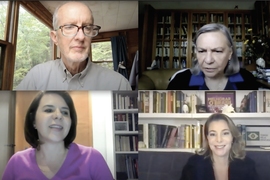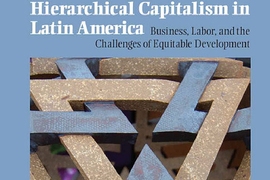As of 2015, about one-third of all 15-year-old students in Latin America lacked rudimentary literacy and math skills, according to the Organization for Economic Cooperation and Development. Those students may have been enrolled in school, but they were not getting an education.
“They’re essentially condemned to a life of unskilled jobs,” says MIT professor of political science Ben Ross Schneider, who calls those cases “a quiet, ongoing tragedy in the region.”
This seems like an obvious area for civic improvement, since more education is strongly associated with better economic outcomes. For individuals, incomes rise about 10 percent for each additional grade completed. For countries in Latin America, a better-educated population can create more growth. And yet large-scale education improvements on the continent are sporadic, and sometimes reverse after they happen. Why is this?
That is the question Schneider carefully examines in his new book, “Routes to Reform: Education Politics in Latin America,” published this spring by Oxford University Press. In it, he analyzes the factors enabling and limiting reforms in several countries in the region, and illuminates the distinctive nature of education politics. Which, he notes, is a vital issue.
“For centuries, the twin scourges and defining features of the political economy of Latin America have been poverty and inequality,” Schneider writes in the new book. “The best and probably only way to overcome these scourges long term is quality education for all.”
Filling an “empty policy space”
Schneider has long studied Latin American politics in comparative perspective. Education politics, he finds, is distinctive for multiple reasons. For one thing, it is a relatively “empty policy space,” devoid of interest groups, or even parents, consistently lobbying in favor of improvements.
“Most education systems in Latin America are national, and it’s hard for parents to have an influence at a national level,” Schneider observes. “And wealthier, well-off parents have mostly moved their kids to private schools, so they don’t care about the public education system.” Indeed, about 40 percent of middle-class families have exited public education in the region, according to a 2014 study.
Moreover, unlike, say, changing interest rates, the effects of upgrading schools take a long time to become manifest, making it harder to solidify political support, and often pushing the issue beyond the timespan of many politicians.
There are many ways to upgrade schools: changing curriculum, lengthening hours, adding technology, and more. Schneider focuses on teaching: He sees value in making it a more rigorous, merit-based career than it often has been in Latin America. That includes better instruction for teachers, merit-based hiring, and systematic evaluations that create more steps on the teaching career ladder.
“The quality of teaching is the most important factor for student learning in schools,” Schneider says, referring to a growing body of research. “There’s a lot to do by recruiting better, training better, providing teachers with more incentives, and giving them a better career as a teacher. It is the best thing, but it is the most politically and organizationally difficult reform to achieve.”
Bottom-up versus top-down
One might think, then, that there still could be enough people who see the broad benefits of improving education, and could form a majority political coalition to bring about change. However, this has happened nationwide in Latin America precisely once: in Chile, where a long period of action and discussion over the issue led to thorough reforms in 2016.
“That is sort of the ideal route to reform, but in almost no other country has there been that kind of electoral mobilization,” Schneider observes. Some states within Brazil also generated at least some grassroots, bottom-up support for an earlier set of reforms that have gained longer-term support.
If there is not a big political movement for change, however, that leaves what Schneider calls the “technocratic option,” a more top-down path of policymaking. The trouble here is that reforms run into already-formed opposition groups: political party machines and some teachers’ unions. And in some Latin American settings, these are related matters, when teaching jobs are distributed as patronage positions.
In Mexico, for instance, the president Enrique Peña Nieto instituted a vigorous set of meritocratic reforms during his tenure, from 2012 to 2018, but his successor, Andrés Manuel López Obrador, promptly reversed many of those changes in 2019. Mexico also has a teachers’ union that is much more enmeshed in machine politics than is the case in many countries, and had the staying power to outlast the reforms.
Schneider readily notes that the politics of Latin American teachers unions is not the same as those in the United States — where matters of qualification and merit are far more firmly established. He also observes that in Latin America, there are multiple types of teachers unions. Some have democratic elections and are more like conventional interest groups, while others have long-running leaders principally interested in preserving their personal power.
“I don’t suggest that teachers unions are always the problem,” Schneider says. The larger issue is that top-down reforms, without broad popular support, can be vulnerable to erasure as soon as the leaders instituting them leave office.
“Chile and Mexico are almost polar opposites,” Schneider says. “Mexico had a great reform that was taken away politically.”
Asking the right questions
For Schneider, then, a central tenet of the study is that there is not one template for improving education; asking which route works best is, he writes, “unfortunately, the wrong question.” Rather, some routes are more or less likely to succeed in certain settings.
Other scholars have praised “Routes to Reform.” Martin Carnoy, a labor economist and professor at Stanford University’s Graduate School of Education, has called it a “valuable book” that “can teach us more generally about how educational change occurs and why it often does not occur.”
Schneider certainly hopes his book will help people understand more about Latin American education and its politics. Some countries have realized significant classroom improvements; others have not. But it is still possible, across the region, that the long-term value of improved education will itself take hold politically.
“There is a virtuous cycle, which is so rare, where reform leads to better student learning, and voters then vote for that,” Schneider observes. “This happened in some states in Brazil, which suggests this could be transferred to other systems. The goal of my book is to show obstacles, but also to show some success stories, so there is hope.”











